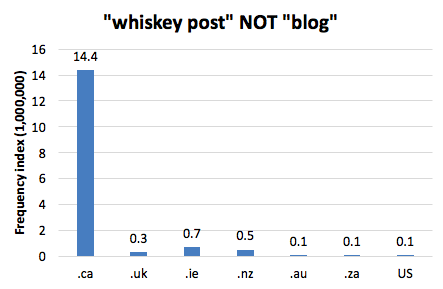Quick links
whiskey post
DCHP-2 (May 2011)
Spelling variants:whisky post
n. — historical, Western Canada, especially Alberta
an establishment selling or trading whisky illegally to Native hunters.
Type: 5. Frequency — Whiskey post was likely the most widely used term in the late 19th and early 20th centuries. As Chart 1 shows, whiskey post is still most frequent in Canada. See the entry on whisky fort for details.
Whiskey post was the most widely used term at the time. Whisky fort, however, has acquired a more pronounced Canadian dimension (see entry).
Quotations
1909
Colonel French was forced to return to winter quarters with his force, but in the meantime he had secured the services of Jerry Potts as guide, whom he detailed to Lt.-Col. Macleod to assist an expedition to the notorious "Whoop-Up" whiskey post. The expedition had been entirely successful. The whiskey trade had been suppressed, the buffalo robes confiscated and the traders heavily fined.
1931
As Col. Macleod and his officers looked down into the valley below the gates were closed; not a man was visible, around the whiskey post; there reigned the silence of the tomb.
1954
Other whiskey posts were built also, but Whoop-up remained the centre and from it terror spread in all directions.
1957
A few miles to the west of town was the site of the old Fort Spitzee, one of the lawless whiskey posts. . . .
1976
Two Southern Alberta locations are among 17 designated as historic sites, Culture Minister Horst Schmid announced Thursday. Massacre Butte near Cowley and the Standoff Whiskey post at the junction of the Belly and Waterton Rivers will be protected by the provincial government as historic sites. [...] The Standoff Whiskey Post was an American post where whiskey was traded with the Indians for furs. It closed with the coming of the North West Mounted Police in 1874.
1984
They were looking for 40 horses stolen from them by a band of Cree. It is indicative of the lack of civilization in the area that to this day nobody knows exactly when the battle took place, although the latest studies indicate it was Sunday, June 1.
There were no missionaries at the whisky posts and both sides spent the Sabbath morning drinking whisky. The raw spirits, cut with water and spiked with tobacco and pepper for flavor, exacerbated the bad feelings between the races.
1996
And the Cypress Hills massacre involved a number of American and Canadian "wolfers" -- guys who poisoned the carcasses of buffaloes, left them out on the prairies, the wolves ate them and they collected the bounty on the wolf pelts. In May of 1873 they were camped outside Fort Benton in Montana and their horses were stolen. They followed the trail of the horses across the border into Canada, spent a Sunday drinking at a whiskey post in the Cypress Hills.
Images
